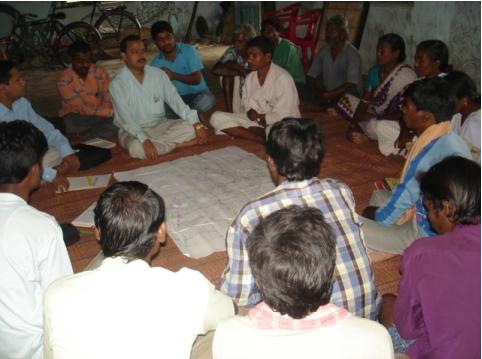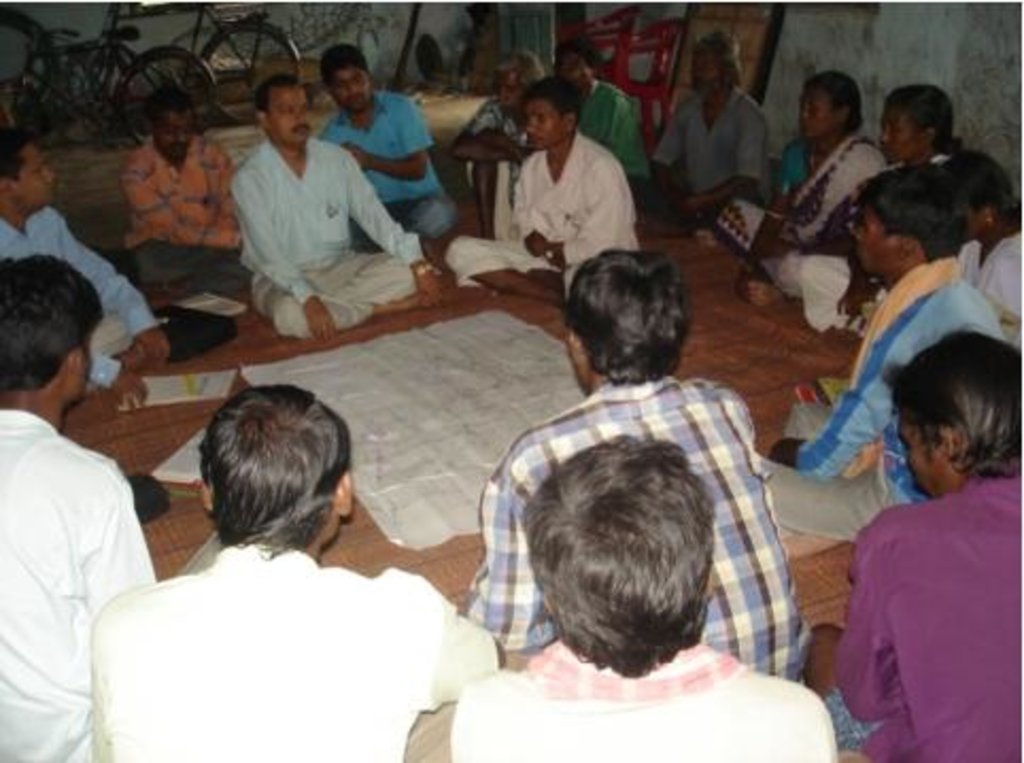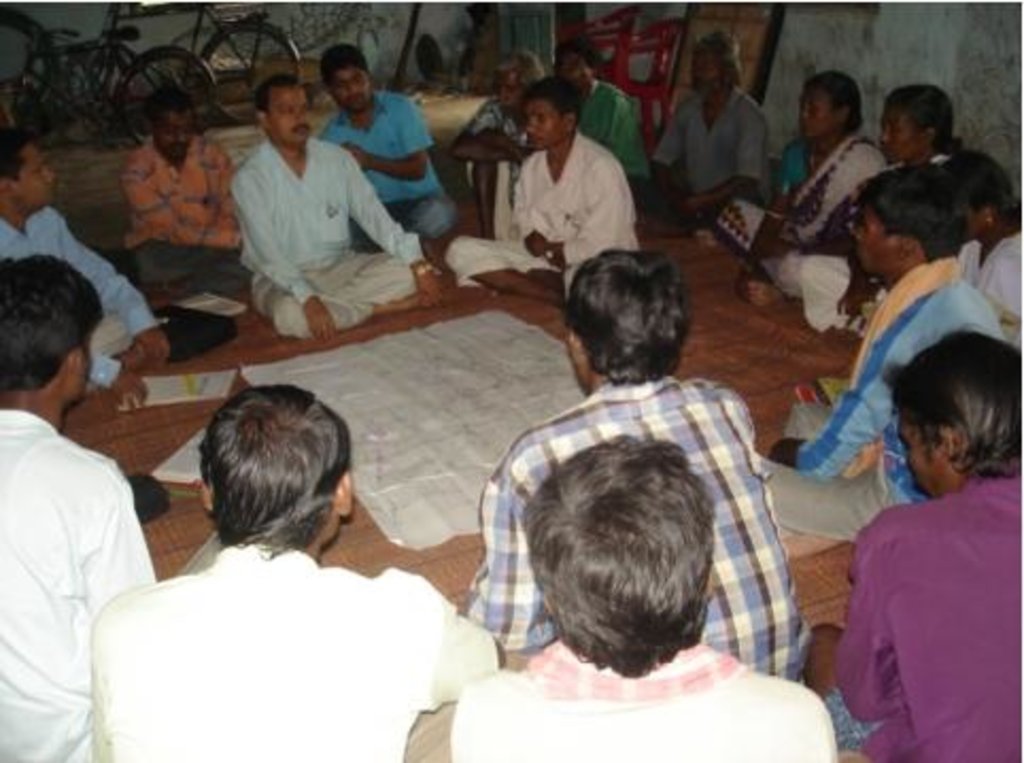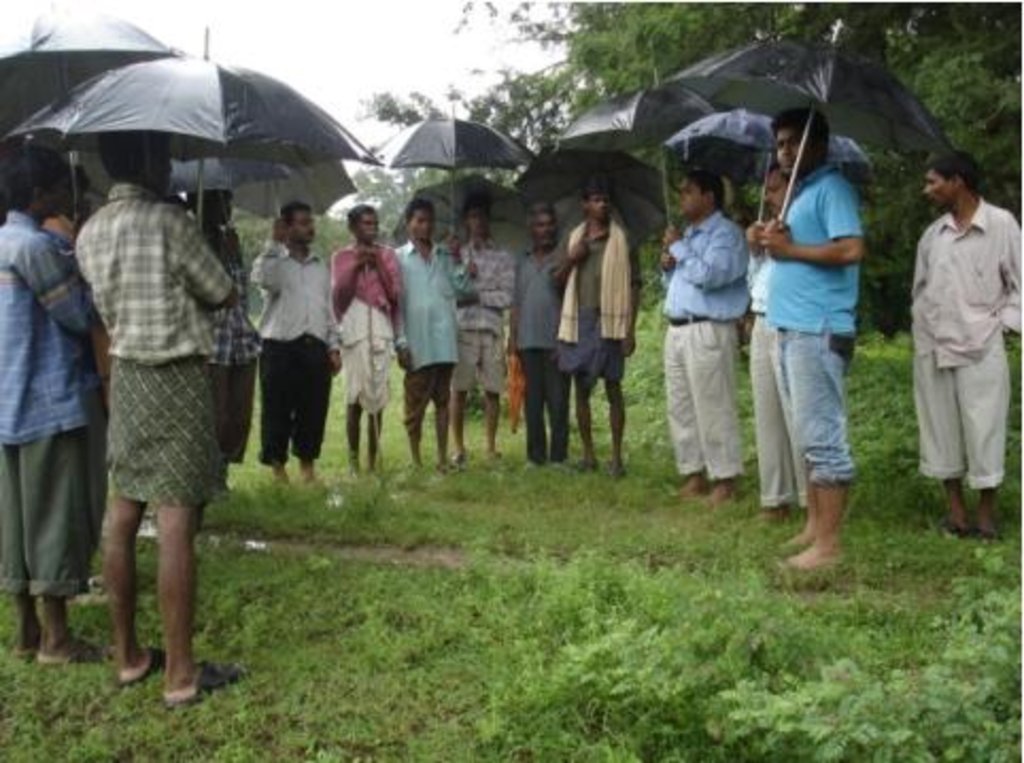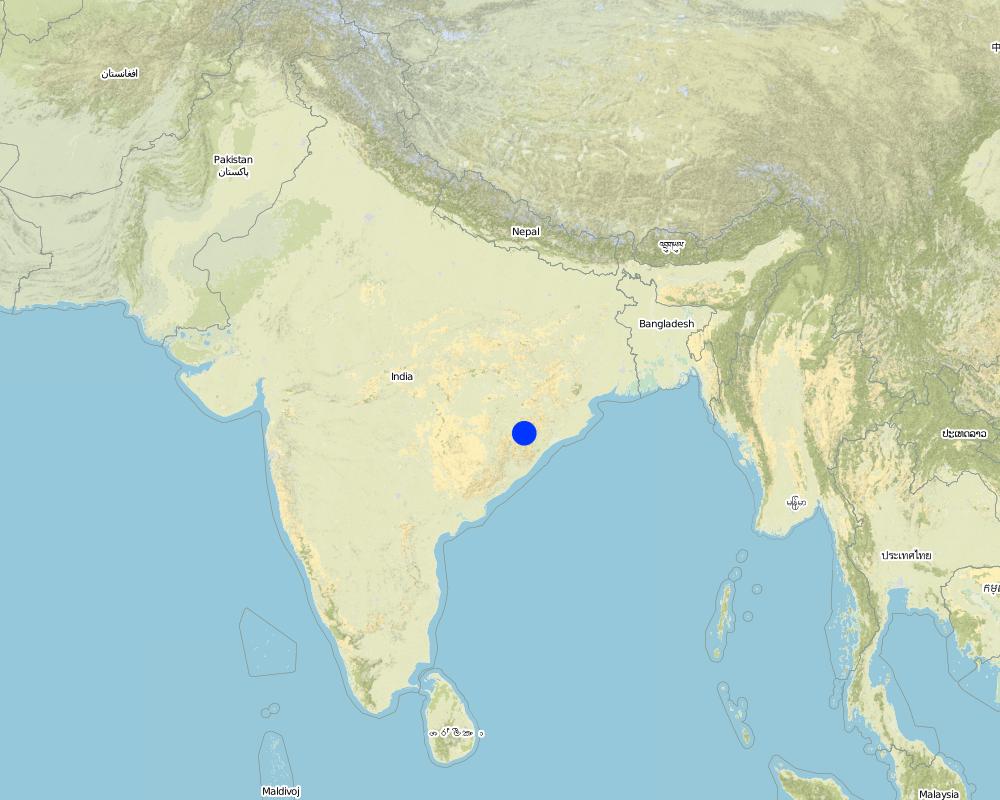Common Interest Group Approach in Watershed Development [India]
- Creation:
- Update:
- Compiler: Philippe Zahner
- Editor: –
- Reviewer: Fabian Ottiger
approaches_2366 - India
View sections
Expand all Collapse all1. General information
1.2 Contact details of resource persons and institutions involved in the assessment and documentation of the Approach
SLM specialist:
Name of the institution(s) which facilitated the documentation/ evaluation of the Approach (if relevant)
Swiss Agency for Development and Cooperation (DEZA / COSUDE / DDC / SDC) - Switzerland1.3 Conditions regarding the use of data documented through WOCAT
The compiler and key resource person(s) accept the conditions regarding the use of data documented through WOCAT:
Ja
1.4 Reference(s) to Questionnaire(s) on SLM Technologies
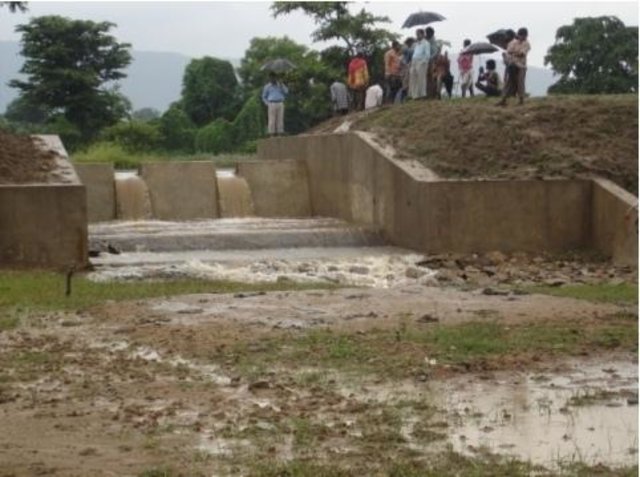
Diversion Weir [India]
Diversion weir is a masonary check dam constructed across a perinnial or semi perinnial stream to divert the runoff water into land users field for irrigation.
- Compiler: Niranjan Sahu
2. Description of the SLM Approach
2.1 Short description of the Approach
Group is formed based on a common interest such as irrigation to their fileds from the diversion weir.
2.2 Detailed description of the Approach
Detailed description of the Approach:
Aims / objectives: 1. To creat village level organisation so that post project maintenance is ensured. 2. To encourage community participation in the programme. 3. To ensure equi-distribution of benefits.
Methods: Common Interest group implements the programme, mobilising resources from the watershed committee.
Stages of implementation: 1. Site selection. 2. Layout. 3. Foundation. 4. Construction of Superstructure. 5. Earthen embankment and guidebunds construction. 6. Turfing. 7. Construction of irrigation channel. 8. User's contribution during the process of implementation.
2.3 Photos of the Approach
2.5 Country/ region/ locations where the Approach has been applied
Country:
India
Region/ State/ Province:
Orissa
Map
×2.6 Dates of initiation and termination of the Approach
Indicate year of initiation:
2005
Year of termination (if Approach is no longer applied):
2010
2.7 Type of Approach
- project/ programme based
2.8 Main aims/ objectives of the Approach
The Approach focused mainly on SLM with other activities (Cropping system, Irrigation)
Oranise community into common interest group; build their capacity, provide financial support and guide them to implement their own programme in a participatory manner so that the post project sustainability is ensured and the benefits from the project reaches to the right people with right propertion.
The SLM Approach addressed the following problems: natural calamity(drought); Poverty;Illiteracy; Sustainability in agriculture production, Poor socio economic conditio of the people
2.9 Conditions enabling or hindering implementation of the Technology/ Technologies applied under the Approach
social/ cultural/ religious norms and values
- hindering
Do not unite to solve a problem
Treatment through the SLM Approach: Organised into groups, identified their common problem and came out the possible solution
availability/ access to financial resources and services
- hindering
People are not able to afford the cost
Treatment through the SLM Approach: WORLP provided financial support for construction of the structure
legal framework (land tenure, land and water use rights)
- hindering
The existing land ownership, land use rights / water rights hindered a little the approach implementation Due to low land holding, the number of land users are high; thus the community mobilisation is less effective.
knowledge about SLM, access to technical support
- hindering
lack technical knowledge
Treatment through the SLM Approach: SWC specialist assisted in planning, designing and implementation of the structure
3. Participation and roles of stakeholders involved
3.1 Stakeholders involved in the Approach and their roles
- local land users/ local communities
Working land users were mainly men
Men are worried about the land degradation and irigation where as women are concerned with the types of crops. 45 marginal and small farmers are benefiting from the structure. They were formed into a group and all the group members were involved during the decision making process like selection of site, layout of the channel etc.
- SLM specialists/ agricultural advisers
- national government (planners, decision-makers)
If several stakeholders were involved, indicate lead agency:
The concept of common interest group was developed by social scientists.
3.2 Involvement of local land users/ local communities in the different phases of the Approach
| Involvement of local land users/ local communities | Specify who was involved and describe activities | |
|---|---|---|
| initiation/ motivation | interactive | Mainly:rapid/participatory rural appraisal; partly: public meetings; Situational analysis was done using participatory tools like Social map ,Resource map and Transect. |
| planning | interactive | rapid/participatory rural appraisal |
| implementation | external support | Mainly: responsibility for major steps; partly: casual labour; Community contribution, Quality control, arraning of materials and labours were the major tasks performed by the land users. |
| monitoring/ evaluation | self-mobilization | Mainly: measurements/observations; partly: public meetings; They were taking measurements as per the estimate while the construction was going on. They were also ensuring proper mix of materials while preparing mixtures of sand, cement, chips. |
| Research | none |
3.4 Decision-making on the selection of SLM Technology/ Technologies
Specify who decided on the selection of the Technology/ Technologies to be implemented:
- mainly land users, supported by SLM specialists
Explain:
The selection of site for the structure was decided by the and users along with the SWC speciality.The positive and negative impact of the structure was discussed while finalising the location.
Decisions on the method of implementing the SLM Technology were made by mainly by land users supported by SLM specialists. SWC specilist helped in making the plan and design of the structure. He also assisted while alyout was given in the field.
4. Technical support, capacity building, and knowledge management
4.1 Capacity building/ training
Was training provided to land users/ other stakeholders?
Ja
Specify who was trained:
- land users
- SWC specialists
Form of training:
- on-the-job
- farmer-to-farmer
- demonstration areas
Subjects covered:
Class room as well as on farm training provided to land users.
4.2 Advisory service
Do land users have access to an advisory service?
Ja
Specify whether advisory service is provided:
- at permanent centres
Describe/ comments:
Name of method used for advisory service: Participatory extension methods and exposure to successful sites, demo plots.; Key elements: Learning by Seeing, Learning by doing; 1) Advisory service was carried out through: projects own extension structure and agents 2) Advisory service was carried out through: projects own extension structure and agents; Extension staff: specifically hired project employees 3) Target groups for extension: land users
Advisory service is inadequate to ensure the continuation of land conservation activities; The staff strength in govt is very less, that is why project has hired experts from open markets and also developed community link workers for extension.
4.3 Institution strengthening (organizational development)
Have institutions been established or strengthened through the Approach?
- yes, moderately
Specify the level(s) at which institutions have been strengthened or established:
- local
Specify type of support:
- capacity building/ training
4.4 Monitoring and evaluation
Is monitoring and evaluation part of the Approach?
Ja
Comments:
bio-physical aspects were regular monitored through measurements
technical aspects were ad hoc monitored through measurements
socio-cultural aspects were ad hoc monitored through observations
economic / production aspects were ad hoc monitored through observations
area treated aspects were regular monitored through observations
management of Approach aspects were ad hoc monitored through observations
There were few changes in the Approach as a result of monitoring and evaluation: Guidebank constructed to increase temporary storage in the structure. Increased participation and ownership. The CIG strengthened. Views of the land users respected and involved in decision making.
4.5 Research
Was research part of the Approach?
Ja
Specify topics:
- sociology
- technology
Give further details and indicate who did the research:
Technology is looked with gender lens. Participatory technology development is an inbuilt strategy in the WORLP project.
Research was carried out on-farm
5. Financing and external material support
5.1 Annual budget for the SLM component of the Approach
If precise annual budget is not known, indicate range:
- 10,000-100,000
Comments (e.g. main sources of funding/ major donors):
Approach costs were met by the following donors: local community / land user(s) (CIG members (50); Watershed Committee/other members (20)): 70.0%; other (Project Support): 30.0%
5.2 Financial/ material support provided to land users
Did land users receive financial/ material support for implementing the Technology/ Technologies?
Nee
5.3 Subsidies for specific inputs (including labour)
- none
If labour by land users was a substantial input, was it:
- voluntary
Comments:
They contributing their labour for PRA, Planning, meeting etc.
5.4 Credit
Was credit provided under the Approach for SLM activities?
Nee
6. Impact analysis and concluding statements
6.1 Impacts of the Approach
Did the Approach help land users to implement and maintain SLM Technologies?
- No
- Yes, little
- Yes, moderately
- Yes, greatly
Got water to their field since the water was diverted. 45-60 acres of land production and productivity increased.
Did the Approach improve issues of land tenure/ user rights that hindered implementation of SLM Technologies?
- No
- Yes, little
- Yes, moderately
- Yes, greatly
Decision making is difficult.
Did other land users / projects adopt the Approach?
- No
- Yes, little
- Yes, moderately
- Yes, greatly
Other Watershed programme in the state has slowly adopting this approach
6.3 Sustainability of Approach activities
Can the land users sustain what has been implemented through the Approach (without external support)?
- yes
If yes, describe how:
They are now empowerd to take their own decisions. They are acting as pressure group and leveraging resources from other line departments.
6.4 Strengths/ advantages of the Approach
| Strengths/ advantages/ opportunities in the land user’s view |
|---|
| 'We will manage the Diversion weir, cultivate paddy, ground nut, Onion and Brinjal.' (How to sustain/ enhance this strength: We will maintain this structure from our own contribution.) |
| Strengths/ advantages/ opportunities in the compiler’s or other key resource person’s view |
|---|
| Community Based Organisation are the local institutions which can manage their own. (How to sustain/ enhance this strength: Limited support as and when required) |
| Self monitoring by the land users |
| Ownership (How to sustain/ enhance this strength: User rights ensured, common fund developed) |
6.5 Weaknesses/ disadvantages of the Approach and ways of overcoming them
| Weaknesses/ disadvantages/ risks in the land user’s view | How can they be overcome? |
|---|---|
| Since, SWC is a big investment. If, for some natural calamaity, the structure collapse it will be very difficult to reconstruct. |
| Weaknesses/ disadvantages/ risks in the compiler’s or other key resource person’s view | How can they be overcome? |
|---|---|
| Sometime over ambitious since social change is very slow | Expectation should not be raised while mobilising the community |
7. References and links
7.1 Methods/ sources of information
- field visits, field surveys
- interviews with land users
Links and modules
Expand all Collapse allLinks

Diversion Weir [India]
Diversion weir is a masonary check dam constructed across a perinnial or semi perinnial stream to divert the runoff water into land users field for irrigation.
- Compiler: Niranjan Sahu
Modules
No modules


